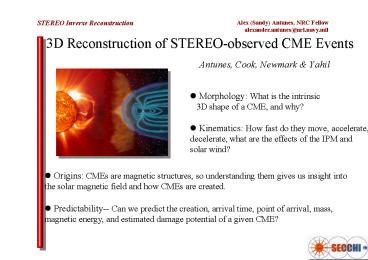3D Reconstruction of STEREO-observed CME Events Antunes, Cook, Newmark - PowerPoint PPT Presentation
Title:
3D Reconstruction of STEREO-observed CME Events Antunes, Cook, Newmark
Description:
3D Reconstruction of STEREOobserved CME Events Antunes, Cook, Newmark – PowerPoint PPT presentation
Number of Views:33
Avg rating:3.0/5.0
Title: 3D Reconstruction of STEREO-observed CME Events Antunes, Cook, Newmark
1
3D Reconstruction of STEREO-observed CME Events
Antunes, Cook,
Newmark Yahil
- Morphology What is the intrinsic
- 3D shape of a CME, and why?
- Kinematics How fast do they move, accelerate,
- decelerate, what are the effects of the IPM and
- solar wind?
- Origins CMEs are magnetic structures, so
understanding them gives us insight into the
solar magnetic field and how CMEs are created. - Predictability-- Can we predict the creation,
arrival time, point of arrival, mass, magnetic
energy, and estimated damage potential of a given
CME?
2
Our Approach Inverse Reconstruction
Front
Side
Front Side
3
Our Approach PIXON (Puetter Yahil)
Data A Data B
- Alternative to maximum entropy methods
- Elements are spatially extended, overlapping
'Pixons' - Uses kernel-based smoothing across Pixons
- Map key is minimum complexity a solution using
fewer underlying Pixon map elements is presumed
to be superior - Produces minimum number of elements required to
fit the solution as allowed by the noise. e.g.
Pixon would consider the bottom pair to be
roughly as good a final goal as the top pair.
Noise A Noise B
DataNoise A DataNoise B
4
Sim Satellites X-Y-Z EclipticData In Recon
Out
'best case' 3-axis input data
Two at 44 (B 76, A 120)
View at 0 44
Data at 0, 90, and from top
Recon at 0, 90, and from top
Recon at 0 44
5
Sim Satellites 3-axis vs Ecliptic 90 44
Flyby
3-axis 'best' case Ecliptic 2-view
case Only 44 separation
3-axis and ecliptic flybys comparing XYZ result
(left) with 'just 2 satellites' ecliptic result
(middle) and 'just 2 at narrow separation' (right)
6
Dec 31st, 2007 CME Reality is Messy and
Evolving
Running Difference
View at 0 44
Data A Data B
Recon A Recon B
View at 0 44
7
CME over time
(unconstrained, uncorrelated solutions)
0222 0252 0322
0352 0422
(running difference reconstruction)
8
(No Transcript)
9
Dec 31st, 2007, 222
Running Difference
Unconstrained using Cone
using FM using FM
Fluxrope FM CME solution
(large)
(small) as comparison
Prior Frame Subtracted
10
Conclusions
- Inverse methods can help distinguish between
current theoretical models, at different solar
distances. - Inverse methods can model asymmetrical features
(which pure forward models cannot). - Inverse reconstruction can separate components.
e.g. for Dec 31, separate the streamer from the
above and lower CME portions - Solution is probability space map for CM
- Computational issues fast, but
resolution-limited and require high S/N
11
Conclusions Collaboration is Key
- Study Kinematics-- CM vs time,
expansion/compression, trace back/fwd - Apply model-based masks
- Separate components
- Overlay Forward Models (Thernisien et al)
- Compare with other geometric methods (de Koning)
- Compare with centroid location (Vourlidas et al)
- Add the '3rd Eye' of LASCO (Cook)
- Let others use our tools
- Wait for a gt90 CME
- Don't like it? Use our framework and tools to
try your own!































